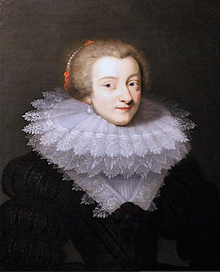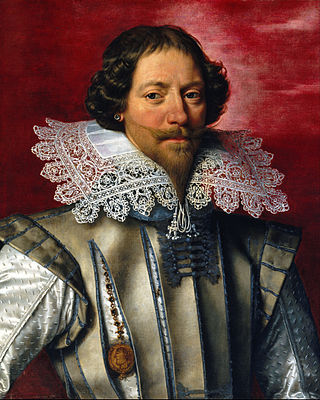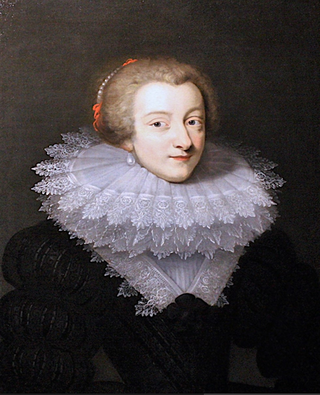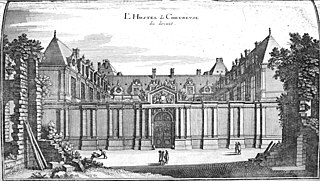
Duke of Chevreuse (French Duc de Chevreuse) was a French title of nobility, elevated from the barony of Chevreuse in 1545.

Duke of Chevreuse (French Duc de Chevreuse) was a French title of nobility, elevated from the barony of Chevreuse in 1545.
The duchy of Chevreuse was originally created for Jean de Brosse, Duc d'Étampes, it was transferred in 1555 to Charles of Guise, the Cardinal of Lorraine, and became a possession of the House of Guise, becoming the title of the Cardinal's grandnephew, Charles de Guise (1578–1657). [1] It was sold in 1655 to his wife, Marie de Rohan, [2] who transferred it to the son of her first marriage, the Duc de Luynes. It has since been held by the ducs de Luynes. [3]


List of dukes of Chevreuse since 1545:
| Number | From | To | Duke of Chevreuse | Relationship to predecessor |
|---|---|---|---|---|
| 1 | 1545 | 1555 | Jean IV de Brosse | 1st Duke of Chevreuse [lower-alpha 1] |
| 2 | 1555 | 1574 | Charles I | |
| 3 | 1574 | 1606 | Charles II | Great-nephew of the preceding |
| 4 | 1606 | 1655 | Claude | Brother of the preceding [5] [lower-alpha 2] |
| 5 | 1655 | 1663 | Marie de Rohan | Wife of the preceding [6] |
| 6 | 1663 | Louis Charles d'Albert | Son of the preceding [7] | |
| 7 | 1663 | 1704 | Charles Honoré d'Albert | Son of the preceding |
| 8 | 1704 | 1735 | Charles Philippe d'Albert | Grandson of the preceding |
| 9 | 1735 | 1768 | Marie Charles Louis d'Albert | Son of the preceding |
| 10 | 1768 | 1807 | Louis-Joseph-Charles-Amable d'Albert | Son of the preceding |
| 11 | 1807 | 1839 | Charles Marie Paul André d'Albert | Son of the preceding |
| 12 | 1839 | 1867 | Honoré Théodoric d'Albert de Luynes | Son of the preceding [lower-alpha 3] |
| 13 | 1867 | 1870 | Charles Honoré Emmanuel d'Albert | Grandson of the preceding |
| 14 | 1870 | 1923 | Honoré Charles Marie Sosthène d'Albert | Son of the preceding |
| 15 | 1923 | 1993 | Philippe d'Albert | Son of the preceding |
| 16 | 1993 | 2008 | Jean d'Albert de Luynes | Son of the preceding |
| 17 | 2008 | Incumbent | Philippe d'Albert | Son of the preceding [8] |

Charles d'Albert, 1st Duke of Luynes was a French courtier and a favourite of Louis XIII. In 1619, the king made him Duke of Luynes and a Peer of France, and in 1621, Constable of France. Luynes died of scarlet fever near the end of that year at the height of his influence.

Marie Aimée de Rohan was a French courtier and political activist, famed for being the center of many of the intrigues of the first half of the 17th century in France. In various sources, she is often known simply as Madame de Chevreuse.

The House of Rohan is a Breton family of viscounts, later dukes and princes in the French nobility, coming from the locality of Rohan in Brittany. Their line descends from the viscounts of Porhoët and is said to trace back to the legendary Conan Meriadoc. Through the Porhoët family, the Rohans are related to the Dukes of Brittany, with whom the family intermingled again after its inception. During the Middle Ages, it was one of the most powerful families in the Duchy of Brittany. The Rohans developed ties with the French and English royal houses as well, and they played an important role in French and European history.
Marie Brûlart, duchesse de Luynes, was a French court official and close friend and confidante to Louis XV's queen consort, Marie Leszczyńska, whom she attended at Versailles for nearly thirty years (1735–63).
The Duke of Luynes is a territorial name belonging to the noble French house d'Albert. Luynes is, today, a commune of the Indre-et-Loire département in France. The family of Albert, which sprang from Thomas Alberti, seigneur de Boussargues, bailli of Viviers and Valence, and viguier of Bagnols and Pont-Saint-Esprit in Languedoc, acquired the estate of Luynes in the 16th century.

Claude de Lorraine, also called Claude de Guise, was a French noble and husband of Marie de Rohan. He was the Duke of Chevreuse, a title which is today used by the Duke of Luynes.

The title of Duke of Chaulnes, a French peerage, is held by the d'Albert family beginning in 1621.

Charles d'Albert, 3rd Duke of Chaulnes, was a French general and diplomat. He was made lieutenant général des armées in 1655, and chevalier des ordres du roi from 1661. He became third Duke of Chaulnes in 1653 on the death of his elder brother.

Charles Honoré d'Albert de Luynes was a French nobleman and Duke of Luynes. He is best known as the Duke of Chevreuse, his family's subsidiary title which he used until his father's death in 1690. He was a high-ranking French official under King Louis XIV.
Charles de Rohan was a French nobleman. His primary title was Duke of Montbazon, and before acceding to that title he was known by his other title, prince de Guéméné. He was the son of Charles de Rohan and Jeanne Armande de Schomberg.

Marie Charlotte de La Tour d'Auvergne, was a French noblewoman and member of the House of La Tour d'Auvergne. Married into the House of Beauvau, a powerful family originating in Anjou, she had a daughter at the age twenty, and died of smallpox at the age of thirty three. The present Duke of Mouchy branch of the Noailles family are descended from her.

Hercule de Rohan was a member of the princely House of Rohan. The second Duke of Montbazon, he is an ancestor of the present Princes of Guéméné. His daughter was the famous Frondeur the duchesse de Chevreuse. He was a Peer of France.

Marie Sophie de Courcillon was a French salonnière, Duchess of Rohan-Rohan and Princess of Soubise by marriage. She was the granddaughter of Philippe de Courcillon, better known as the marquis de Dangeau. She was praised for being a cultured woman for the age and held a fashionable salon at the Hôtel de Soubise in Paris. She was painted by Nattier.

The former Hôtel de Chevreuse was a Parisian hôtel particulier located at 33 Rue Saint-Dominique, just south of the Église Saint-Thomas-d'Aquin.

The Hôtel de Chevreuse was an aristocratic townhouse, built in 1622 and located on the west side of the Rue Saint-Thomas-du-Louvre on a site now part of the Cour Napoléon on the west side of the Louvre in Paris, France. The hôtel was destroyed in 1834.

Louis Charles d'Albert, 2nd Duke of Luynes, was a French nobleman and peer of France. He was a translator and moralist who was the first translator of the work of René Descartes.
Louis Joseph d'Albert, 3rd Prince of Grimberghen was a French nobleman who was in the service of the Emperor Charles VII, and became field-marshal and Ambassador in France.

Amable Antoine Jacques Emmanuel de Crussol, 12th Duke of Uzès, known as theDuke of Crussol from 1843 to 1872, was a French soldier and politician.
Louis Emmanuel de Crussol, 14th Duke of Uzès was a French aristocrat and art collector.